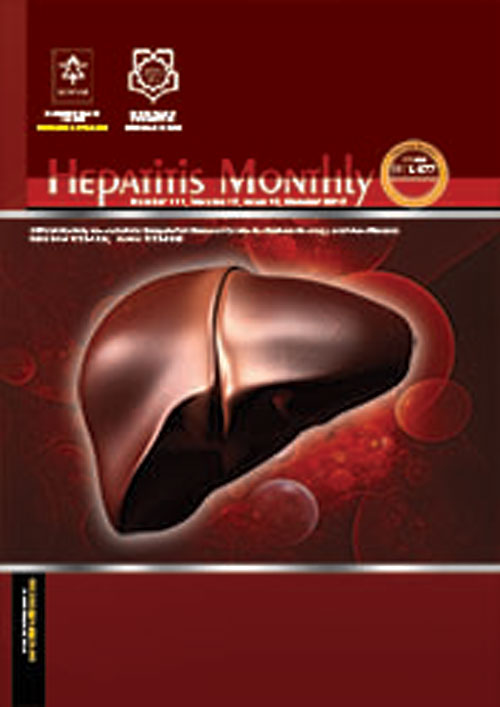فهرست مطالب

Hepatitis Monthly
Volume:18 Issue: 3, Mar 2018
- تاریخ انتشار: 1397/01/09
- تعداد عناوین: 4
-
-
Page 2BackgroundPrevious studies showed a significant prognostic value of 3-year and 5-year evolution of noninvasive fibrosis tests in European chronic hepatitis C (CHC) patients with or without HIV. It is uncertain whether this conclusion can be extrapolated to Chinese patients and whether the assessment of noninvasive fibrosis tests in a shorter time interval still has a prognostic value.ObjectivesThe study aimed to assess the prognostic value of changes of aspartate aminotransferase-to-platelet ratio (APRI) and fibrosis-4 (FIB-4) in consecutive years in Chinese CHC patients.MethodsThere were 173 CHC patients enrolled in 2 centers in this retrospective study. APRI and FIB-4 were calculated every 12 ± 2 months. The average difference between 2 adjacent calculations was defined as an annual change (AC). Risk factors were evaluated by Cox proportional regression models.ResultsCirrhosis, hepatic decompensation, hepatocellular carcinoma, and liver-related death developed in 29 patients during the median follow-up of 47.0 (29.5 - 72.0) months. Baseline FIB-4 and APRI, Child-Pugh class C, non-sustained virologic response (SVR) to interferon (IFN) or Pegylated IFN plus ribavirin, and AC of FIB-4 were significantly associated with liver disease progression. AC of FIB-4 (P 3.25 and AC of FIB-4 > 0.22, or non-SVR and AC of FIB-4 > 0.22 had the highest cumulative incidence of liver disease progression among the 4 groups identified according to baseline FIB-4 and AC of FIB-4, or SVR and AC of FIB-4.ConclusionsAn increased FIB-4 over time is an independent risk factor of liver disease development in Chinese CHC patients. Monitoring FIB-4 annually may help physicians to predict prognosis in CHC patients.Keywords: Chronic Hepatitis C, Cirrhosis, Sustained Virologic Response, Aspartate Aminotransferase, to, Platelet Ratio, Fibrosis, 4
-
Page 3BackgroundHIV and Hepatitis C (HCV) infections are increasing in Tajikistan. While injection drug use (IDU) is a known risk factor for coinfection, little is known about non-injection drug users (NIDU).ObjectivesThe aim of this study was to identify factors associated with HIV-HCV coinfection and HIV infection alone among IDU and NIDU.MethodsData from Tajikistans national HIV/AIDS registry data for all adults aged 18 years and older who had received a HCV test from 2006 to 2016 were obtained. Chi-square analyses identified factors associated with coinfection and injection drug use.ResultsOf the 1849 people living with HIV who received a Hepatitis C test, 36.2% were positive for HCV and 63.8% were negative. Coinfection occurred among 74.4% of IDU and 18.5% of NIDU. In bivariate analyses, among both IDU and NIDU, coinfection was associated with urbanness of living location, having partner with a positive HIV test, marital status, region, and being imprisoned. Among IDU, coinfection was also associated with migrant status. Among NIDU, coinfection was also associated with gender, age at diagnosis, and AIDS stage at first diagnosis.ConclusionsThis study shows that coinfection occurs most frequently among IDU in general, but that NIDU represent an important population deserving of additional study and tailored HIV and HCV prevention programs. Additional research to identify best practices for targeting NIDU and people living in at-risk regions for screening and are required to effectively prevent and then appropriately manage coinfection.Keywords: HIV, HCV, IDU, NIDU, Tajikistan

